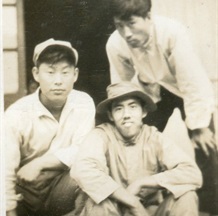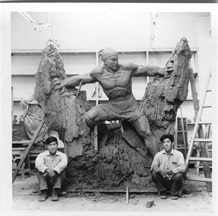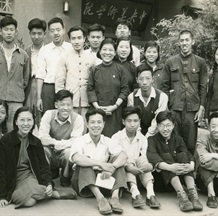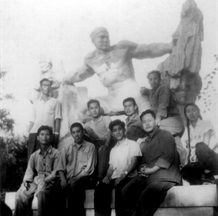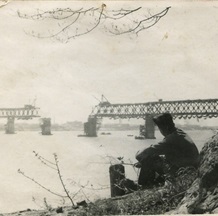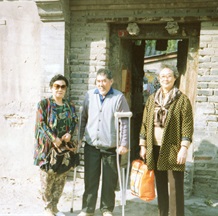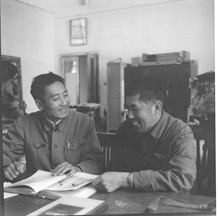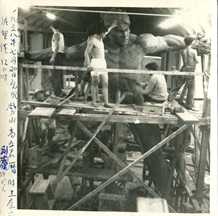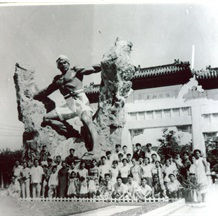Let’s first talk about my old friend. Old friend! Well, that’s true. We have known each other for a full fifty years up to now, as such a long time has passed so we are old friends. According to the ancient meaning of the Chinese characters: “people with common goals are called comrades (You, CN.友), and the fellow mates are called friends (Peng, CN.朋).” We were both under the tutelage of Mr. Wang Linyi and have a lot in common in our artistic views. Therefore, the word “friend” (Peng You, CN.朋友) is the right term used to describe our relationship.
As far as the happy news is concerned, it is not easy for sculptors in China to publish a personal collection. Of the generations of teachers and peers who have worked hard all their lives, many have never had a personal exhibition or published a catalogue. When it comes to the West, it is common for sculptors there to hold an exhibition or publish a catalogue within three to five years. It’s not that my teachers and friends are of a lower standard or have fewer works, but for other reasons. When there was a planned economy in China, everything was planned and many people could not get in line for a lifetime, but now it is the market economy in which people cannot afford to have their books published with no money. Under such circumstances, I am certainly happy to see Mr. Shiming has his personal catalogue published.
There is another reason for being happy. Actually, he is not a social person, so not many people know him except those in his circle. On the contrary, his works are very remarkable, standing out from the ordinary. It is a joyous occasion to contribute these works to society and to add a wonderful flower to the art garden.
As a native of Tianjin, Mr. Liu Shiming chose to major in sculpture because he was fascinated by art from a young age. The many hobbies he had from his childhood were in turn reflected in his lifelong creations, dissolved into his sculptures.
In 1946, Mr. Xu Beihong re-established the National Art School in Beiping. It was in this year that Mr. Liu Shiming entered the Sculpture Department and became one of the first students admitted by Mr. Xu Beihong himself after the victory of the War of Resistance Against Japan. After the enrolment, he studied in Mr. Wang Linyi’s class. Only three students were admitted to the Sculpture Department that year, and the other two were Mr. Yu Jinyuan and Mr. Liu Xiaocen, both of whom went on to make great achievements.
I was admitted to the Sculpture Department during the summer vacation in 1948, and I have known Mr. Liu ever since.
During the Red May Creative Movement before his graduation, Mr. Shiming created his work “Measuring the Land”, which reflected the land reform and was later collected by the Czechoslovak Republic. During the movement of the Great Leap Forward, he created “Splitting the Mountains to Let the Water Flow”, which was placed in front of the memorial archway of Protecting Peace in Zhongshan Park. It was later shown in the “Art Exhibition of Socialist Countries” in Moscow. It is a work of high artistic standards, which is now preserved in Dongfeng Park in Baoding.
Mr. Shiming went to Sanmenxia in the 1960s to experience life. One morning, while he was walking along the road, suddenly came the mournful sound of the banhu (a traditional Chinese musical instrument). When he heard the sound of the banhu coming from a hut next to the railway, with the tune of Henan Bangzi (a form of local opera of Hennan Province), he stood there dumbfounded for a long time as if he had lost his soul, forgetting to walk on. It was just at that moment that perhaps the Goddess of Athena had aroused his long accumulated secret of treasure deep in his heart so he decided to leave Beijing that everyone yearned for, with his luggage packed, heading south along with the melody of the banhu, to the hometown of Henan Bangzi, seeking inspiration and seeking dreams.
The topic of destiny has been talked about for thousands of years, and nobody can explain it clearly, but only ends up in two words, “cannot tell”. One can only abide by the mercy of his fate and there is nothing he can do about it, especially when everyone becomes a percentage in front of the heroic hype. It was at that time that Mr. Liu Shiming arrived in Henan. First came the decentralization of schools, then the “four cleans movement”, and then the unprecedented Cultural Revolution. In a nervous state of mind, how could he get down to art. For him, who was better at art creation but short of sophistication, it is fortunate that he survived under the tough situation.
It was during this period that he had accumulated a great deal of source materials for a new creative climax to come.
Before the Cultural Revolution, a stage education exhibition was held in Shandong Province, which had a great impact. I was, at that time, a waste to be reused (original words) and was transferred from the district to Jinan to participate in this activity. The situation for me was one day ploughing in the filed and another day taking out dung in the toilet, undergoing thought reform through labour.
One day my superior asked me to be part of a reception group for a Henan delegation. I was a bit surprised and with misgivings when I saw Mr. Liu as soon as I entered. It was a pleasant surprise to meet a friend in another place. What we talked about has been completely forgotten after all these years and what I still remember is that he had a bottle of cough syrup in his coat pocket and he took a sip from it every now and then. The meeting was so emotional that it still haunts me even today and I can never forget it. After I was given a bad name (a hat of crime) in the political movement of May Seven in 1966, I had to stop the contact with all my old friends because I did not want to implicate others. In a work unit engaged in class struggle, someone who dared to come to look for an old friend and ask for a meeting was nobody but Mr. Liu.
It was only twenty years ago that we really started to get along. At that time, he had returned to Beijing and soon returned to the Academy, and we worked in the same Sculpture Department, with the doors of our studios opposite each other’s. His studio had a very thin roof and it was cold in winter, so he came to my studio for the winter. This was a period when I gained a deeper understanding of him about his personality and his art.
I will talk about what I have known about him from the outside to the inside.
Dressing casually, he is by no means clean and tidy. In terms of tidiness, he is not, due to his nature. As for cleanliness, he is superb, because he has a good wife at home to look after him. He wears rubber shoes all year round, and when he can’t stand the suffocation, he puts a circle of air holes in the upper part of his shoes. The inverse way he wears his work clothes can also be called unique, with buttons at his back, unbuckled but tied with a small belt. He makes it a rule that he doesn’t go bare-chested even when he is all of a sweat. It has been common practice for artists to be unkempt since ancient times, and in fact, it is similar in our country, but Mr. Shiming does it naturally, not deliberately. One of the reasons is out of habit and he has no time to care about it. Another is out of instinct, not to hold on to fashion. The style is as the man, and so are his works, driven by inspiration, without any elaboration. Mr. Shiming never complains. It’s not because everything is as it should be, but because he doesn’t care about it, staying away from current affairs and politics. What he goes a little too far for is that he does not even discuss the terminology of the new wave of art, such as a post-modern, avant-garde or pure art, as if he doesn’t care much for them. What he is most interested in is to recall his bumpy and romantic experiences. The story is told in a straightforward manner, without expression or embellishment, but it is also touching. Over time, it is clear that he is actually conceiving a new idea for his work in that way. There is an ancient saying: "Conceiving in three occasions: in the bed, in the toilet and on a horse". His idea inspired by a casual conversation should be new and unique. In fact, what he spoke about soon afterwards became his new sculpture on the shelf. His works should belong to the category of freehand, not seeking to be neat and tidy, but simply to express his feelings. For a person trained in the professional art school, he is far from minor skills but close to the major pursuit, and we can see his artist realm from the story to the creation.
Story: Going down the Yangtze River from Wuhan to Huangshi, one can see both the river from the side of the boat from afar, and overlook the surface of the river. A small wooden boat going in the same direction, rowed by a young boatman, sturdy and agile, with a tiller between his legs, his hands pushing the oars, a clay stove sitting in front of him, a roll of cloth lying beside the stove, a small face appearing from the roll of cloth, which is swaddling. This is a home, the home on a boat. When the ship overtakes it, the small boat falls behind. Gradually the distance is widening, and finally, it is out of sight. “The only thing to see is the Yangtze River flowing in the skyline”. It was a first sight that would not have been indifferent but novel to a single man from the north. His series of works about small boats were created in his mind’s eye full of heart-moving scenes, in a stacked variation of the drafts, with such a genuine and heartfelt feeling that one cannot help but be moved.
Story: A child pulled out a small bird, put it in a cage and hung the cage on the eaves of a house. This was a baby bird, not yet feathered and with a yellow beak, leaving the nest for the first time and chirping incessantly. One day, out of the blue, an old bird came to feed her offspring. It flew away up to the roof as soon as it saw people, but refusing to leave. Deeply moved by this scene, the first thought was to release the bird, and the second was to create a series of sculptures on the subject of nests because he wanted the young birds to return to their nests, huddle with their siblings, with beaks open wider than their heads up towards the sky waiting for feeding, and with the mother bird standing by the nest. This almost primal simplicity of feeling is the very realm of poetry.
Story: Once while walking along the embankment, he saw a man struggling to walk up from the foot of the embankment, carrying a wooden box-like object on his shoulders, which was actually two boxes connected together by sticks. When the locals told him about it, he realized that it was a small double-rigged boat and that the man carrying it was a fisherman. This scene stayed in his mind for years until he returned home and created a sculpture of “Man with Boat and Cormorants”. For some reason, whenever I was confronted with this work, it reminded me of Miller’s work the Farmer.
Story: It’s a bit more troublesome to tell this story. Perhaps by nature, Mr. Shiming grew up loving folk arts, such as local opera, folk music, paper-cutting and face painting. Regarding music, today’s Central Conservatory of Music, which was then the Music Department of the National Art School in Beiping, mainly focused on Western music at the time. The courtyard echoed the melodies of Beethoven and Mozart all day long. Immersed in this atmosphere, instead, he likes classical and Buddhist music. Peking opera is popular in Beijing, which has recently been elevated to the status of a national opera. People are usually proud if they can sing a few lines, but in this atmosphere, he is partial to local operas instead, especially the ones of the clapper type, such as Hebei Bangzi, Shanxi Bangzi, and Henan Bangzi. It is a bit odd that he is not influenced by the stylish trend.
As a student at the time, he did not have much money, so he saved his money and bought a lot of records, such as those of the famous actress Jin Gangzuan, Qin Fengyun and Chen Jiayou (these were famous actresses from 50 or 60 years ago, not many people know them now), and listened to them over and over again without getting tired. When the famous Hebei Bangzi actress Li Guiyun performed at the Jixiang Theatre, he went to see the performance every night. After liberation, he watched Guo Lanying’s Shanxi Bangzi Qin Xianglian. It was not until forty years later that Guo Lanying, accompanied by Professor Yang Xianjan and his wife, visited Mr Liu’s home and he fulfilled the dream of talking with her across the table. In this way, the love becomes an obsession, and then yearn for it heartily with nothing to stop it, but reaches the point of rising up and doing it. It is for this reason that he was summoned by the sound of the banhu so as to move away from his hometown in Beijing to go resolutely south. Back to that year, this choice did baffle many people at the Central Academy of Fine Arts, and it was because people only saw the result but did not know the cause. There seems to be something inevitable, not all of a sudden, as where there is smoke, there is fire.
Mr. Shiming’s love of theatre has led him to create “Performer Backstage Series”. There are a number of works of art with theatre as the theme ranging from the master Guan Liang to folk clay figures and paper-cuts, which, not surprisingly, present the front stage most of time. And his works on the theme of the backstage performance of the actors/actresses themselves are so rich in life. With my limited knowledge, I suppose he is the only one. Is there anyone who has seen the colourful costumed female leading heroine nursing her baby with bare breast and holding the baby to piss? Is there anyone who has seen this theatre box with a chicken on it and a dog next to it? All these have brought the actors and the audience closer together at once. It all comes as a surprise that “they are rural women in Henan but not dressed like famous actresses”.
Other extraordinary works include “Man Playing Suona” and “Ansai Waist Drummer” from “the Loess Plateau Series”. I think they should also have a lot of stories behind them, full of the poetic quality or flavour. Yes, art has to be poetic in nature, whether it’s a singing of the legendary stories in the music of folk instruments, or a dancing of performance with an elegant fan covering half of the face, or lonely fire in the desert, or a small bridge over the flowing water, which is poetic and better than nothing.
I have rambled on and on, hummed around and around, nagging endlessly, knowing well it is never enough to introduce this eccentric talent. He is compared to a great river, and what I write is just a spoonful of water. At this point I think I can stop, but I would like to borrow an advertising slogan: “By far not enough”. Mr. Liu Shiming, with his long face, thick eyebrows and round eyes, just resembles a child. His abdomen is not yet bulging, but obvious to see, so he was once jokingly teased as an Arhat. One day, when he met Mr. Ye Qianyu, Mr. Ye looked at him for a moment and said, “This man can be included in the painting”, so both of them burst into laughter. It turns out that both of them recalled that fifty years ago, Mr. Ye painted a portrait of Mr. Liu. Today I have written so many words, hoping that you can understand Mr. Shiming better.


